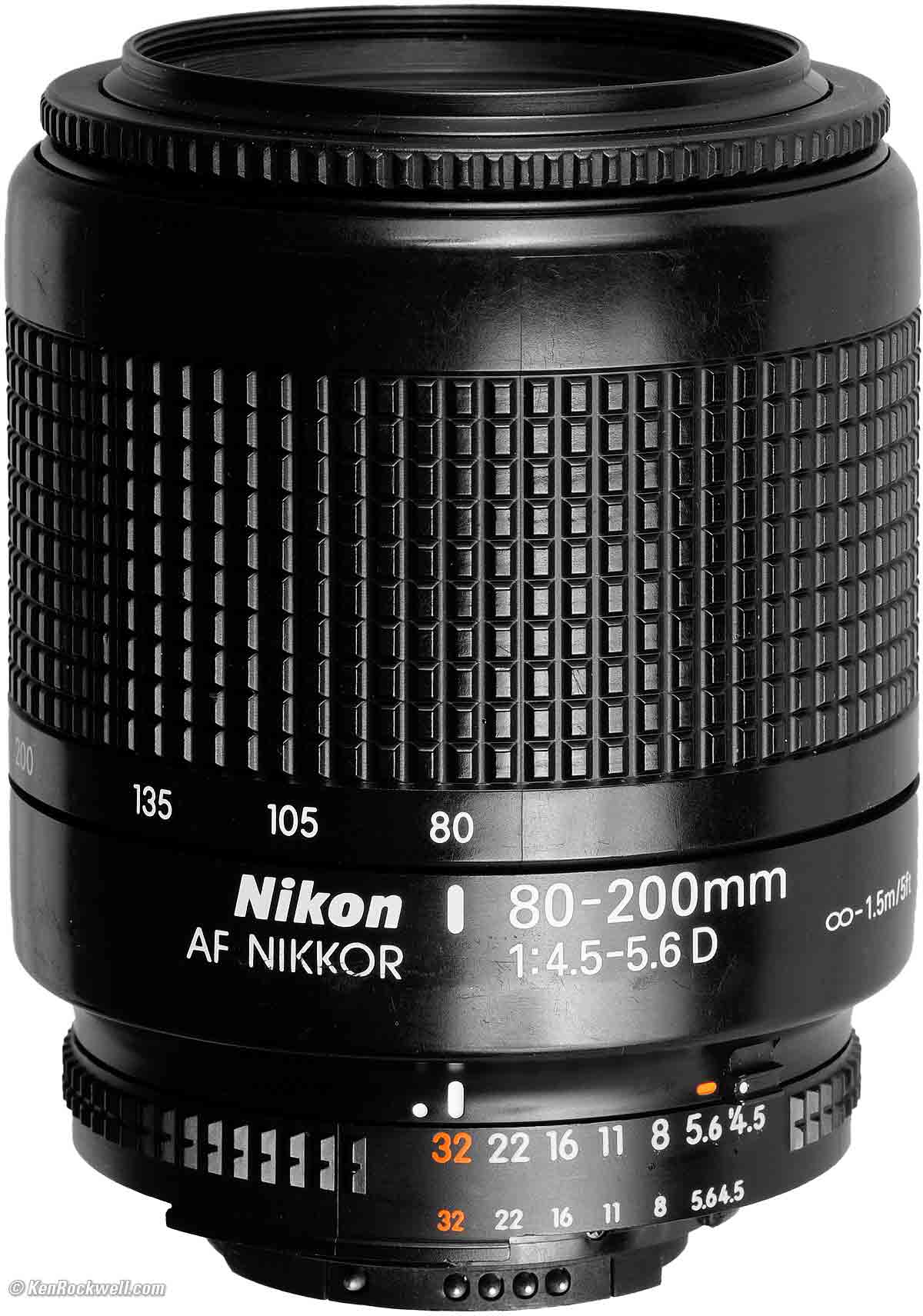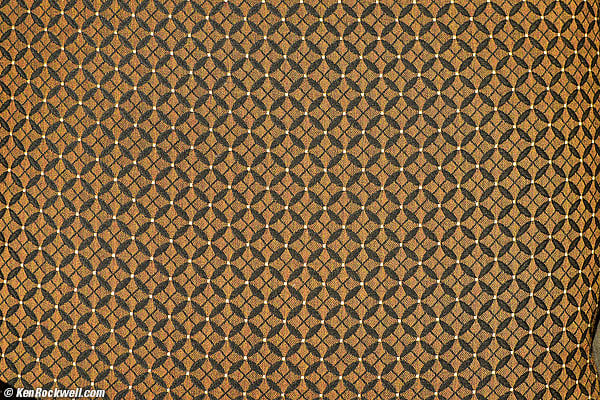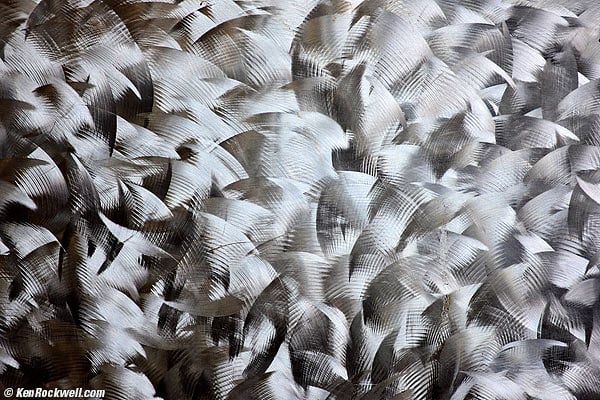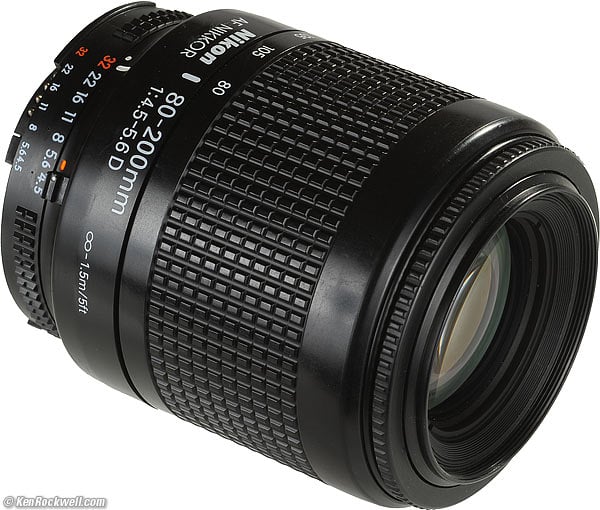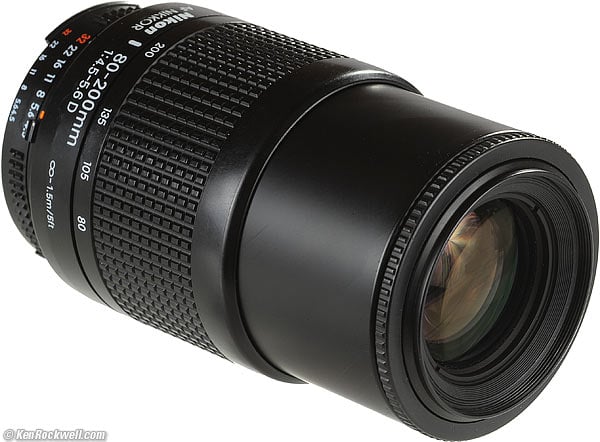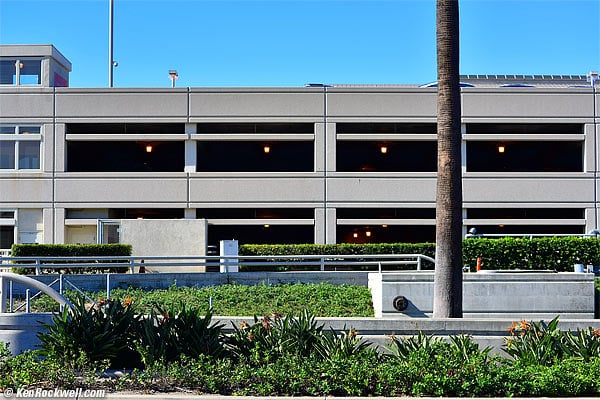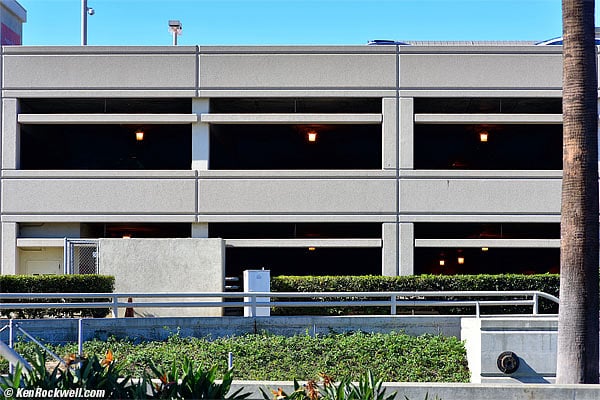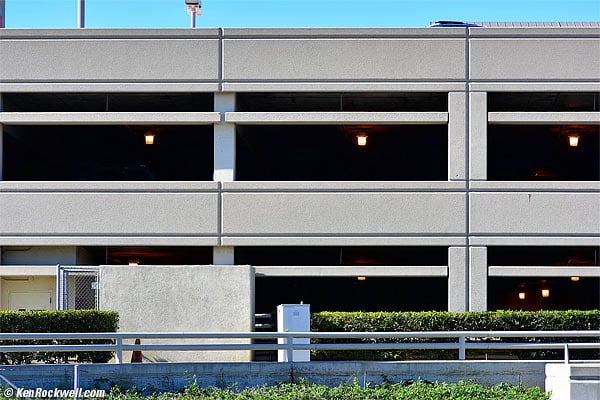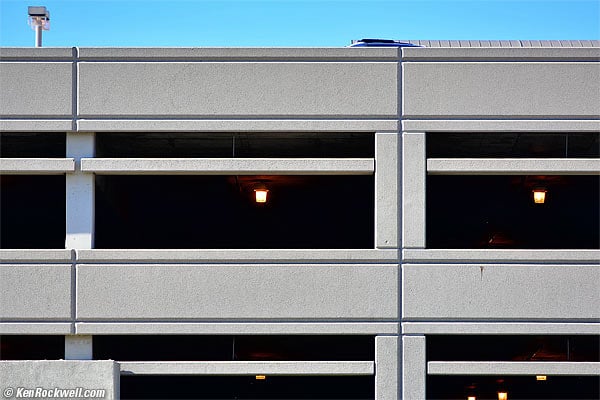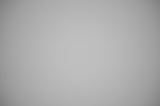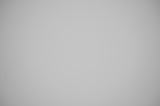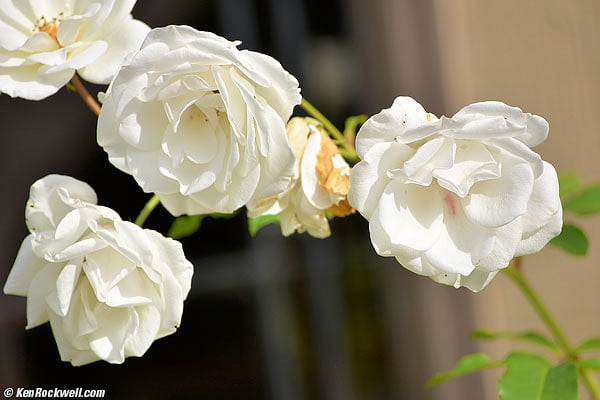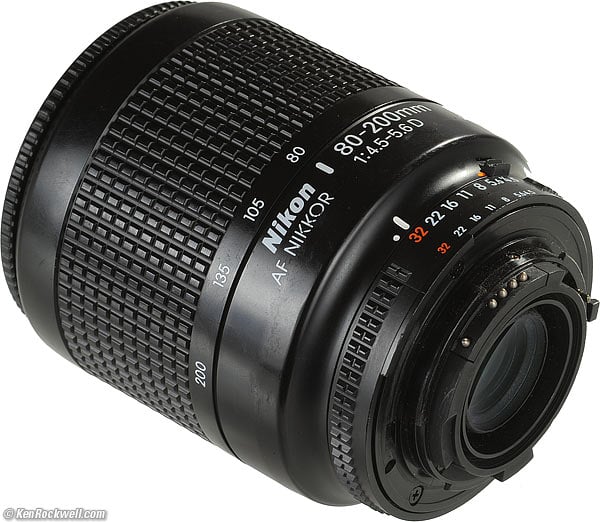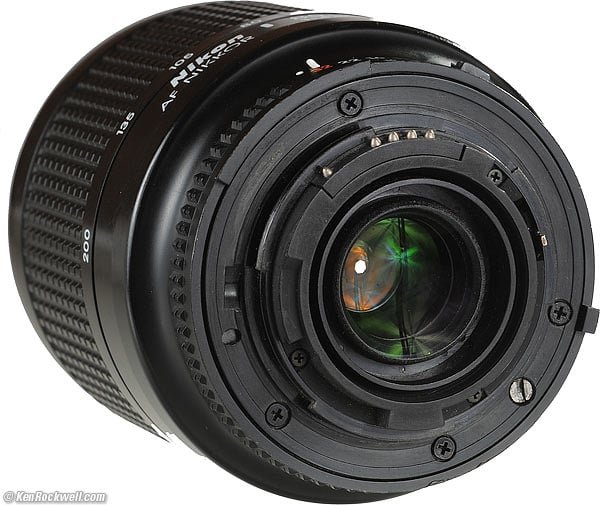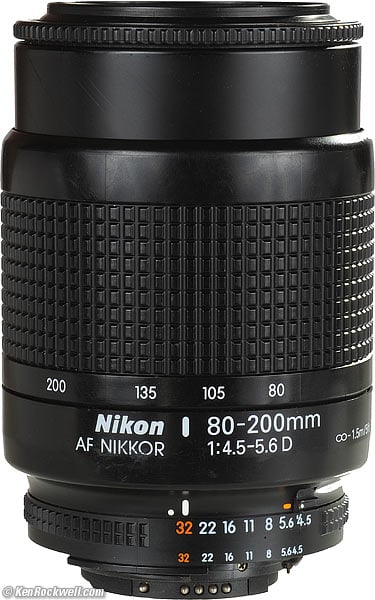Home Donate New Search Gallery Reviews How-To Books Links Workshops About Contact
Nikon 80-200mm f/4.5-5.6
Nikon's Lightest Telephoto Zoom (1995-1999)
Samples Intro Specs Performance Compared Recommendations
Nikon 80-200mm f/4.5-5.6 D AF (FX, DX and 35mm coverage, 52mm filters, 11.7 oz./332.8g, 4.9'/1.5 m close focus, about $50 used). enlarge. I got mine at this link directly to them at eBay (see How to Win at eBay).
This free website's biggest source of support is when you use those or any of these links to approved sources when you get anything, regardless of the country in which you live — but I receive nothing for my efforts if you take the chance of buying elsewhere. I get no government hand-outs and run no pledge drives to support my research, so please always use any of these links to approved sources for the best prices, service and selection whenever you get anything. Thanks for helping me help you! Ken.
Ideal Uses: Super-lightweight, disposable plastic-mount lens for use on FX digital, DX digital and film cameras. It gives images about as good as Nikon's pro f/2.8 zooms, for 1/10 the cost and 1/4 the weight. It's all plastic, except for the autofocus gears and the glass.
Not for: Men who want solid, meaty lenses. Not for night sports, theatre or low-light hand-held. This lens will not autofocus with the cheapest D40, D40x and D60; get the 55-200mm VR instead for those cameras.
April 2018 Nikon Reviews Nikon Lenses All Reviews
Sample Images (more throghout the review) top
Samples Intro Specs Performance Compared Recommendations
Fabric, 21 November 2014. Nikon D810, 80-200mm at 135mm at f/5.6, 1/125 at ISO 100. Camera-original file. Not bad for a weightless $70 lens, eh — and remember that the sides of this curved pillow aren't in focus.
Curved Steel Trim, 23 November 2014. Nikon D810, 80-200mm at 200mm at f/5.6, 1/250 at ISO 640, Perfectly Clear V2. Full-resolution file. This is a curved part of a restaurant The sides aren't in focus.
Introduction top
Samples Intro Specs Performance Compared Recommendations
|
|
Compatibility History Production Pricing
The 80-200mm f/4.5-5.6 D AF was Nikon's cheapest, lightest, junkiest plastic AF telephoto zoom ever. In spite of this, it works fine. The only Nikon telephoto zoom to weigh less is the non-VR 55-200mm, but it doesn't cover film or FX. This lens does, and still weighs less than the tiny 55-200mm VR.
I wouldn't go out of my way looking for one unless you're an outdoor adventurer like Galen Rowell or the sort of backpacker who cuts the handles off toothbrushes to save weight, but if you do use one, it works fine and can create outstanding images.
Its sharp, easy to zoom and has swell bokeh. Its biggest limitation is that it focuses only as close as 5 feet (1.5m), which is as good as all of Nikon's pro f/2.8 tele zooms, but not as close as newer amateur zooms. Personally, a 5 foot minimum distance drives me nuts; the almost as light 28-200mm G gets to within a foot and a half (0.44m) for example.
Compatibility back to intro back to top
The 80-200mm f/4.5-5.6 DAF works great with almost every film and digital Nikon camera made since 1977. If you have a coupling prong added to the diaphragm ring, it's perfect with every Nikon back to the original Nikon F of 1959.
The only incompatibility is that it will not autofocus with the cheapest D40, D40x and D60, but if you focus manually, everything else works great. The D40, D40x and D60 even have in-finder focus confirmation dots to help you.
See Nikon Lens Compatibility for details on your camera. Read down the "AF, AF-D (screw)" column for this lens.
History back to intro back to top
The 80-200mm f/4.5-5.6 D AF came out in 1995, and went away in 1999.
No big deal; it went away because people insisted on 300mm zooms like the 75-300mm, even if at f/5.6 on film there was little chance of getting a sharp photo without VR.
Production back to intro back to top
Nikon made about 200,000 of these, which made it relatively popular back then and easy to find used today.
Pricing back to intro back to top
Price, new* |
Corrected for inflation, 2008 |
|
1996 |
$200 |
$280 |
1997 |
$200 |
$275 |
1998 |
$160** |
$215 |
2008 |
||
2014 |
||
4/2018 |
* At full NYC discount. Very few people bought their lenses this inexpensively back then.
** $135 gray ($181 corrected for inflation in 2008).
Nikon 80-200mm f/4.5-5.6 D AF. enlarge.
Specifications top
Samples Intro Specs Performance Compared Recommendations
Optics
10 elements in 8 groups.
It's partly multicoated, which Nikon calls Nikon Integrated Coating.
Close Focus
5 feet (1.5m).
Maximum Reproduction Ratio
1:6.2 (0.16x).
Hard Infinity Focus Stop?
No.
Focus Scale
No.
Depth-of-Field Scale
No.
Infra-Red Focus Index
No.
Diaphragm
7 conventional blades.
Stops down to f/32-40.
Aperture Ring
Yes.
Full-stop clicks.
Filter Thread
52mm, plastic.
Rotates with focus but not with zoom.
Size
Nikon specifies 3.4" (87.5mm) extension from flange (3.8" [96mm] overall) by 2.8" (72mm) diameter.
Weight
11.742 oz. (332.85g). measured.
Nikon specifies 11.64 oz. (330g).
Hood
Optional HR-1 Rubber, same as original 50mm f/2.
Case
Optional CL-15S or pouch #62.
Teleconverters
TC-14A, but it becomes manual focus and too slow for consistent results with the electronic focus assist with AF and digital cameras. With a lens this slow, forget TCs.
Performance top
Samples Intro Specs Performance Compared Recommendations
Overall Focus Bokeh Color Distortion Falloff Filters
Color Fringes Macro Maximum Aperture Mechanics
Nikon 80-200 zoomed to 200mm. enlarge.
Overall back to Performance back to top
The 80-200mm f4.5-5.6 D AF performs much better than you'd think. Images are sharp, crisp, clear, well exposed and colorful on the D3 and D300.
Focus back to Performance back to top
AF Speed
AF Speed is on the slow side, but it's still OK. It's fine used on a fast camera like the D3 or F6.
One full turn (two half-turns) of the AF screw pulls focus from infinity down to 30 feet.
AF Accuracy
AF is always right-on, not difficult for a slow lens like this.
Manual Focus
Manual focus is OK. You have no real manual focus ring, just a thin ribbed plastic ring at the front. You have to move the M/S/C or AF/MF switch on the camera to M.
The 80-200mm f/4.5-5.6 D AF works fine on manual focus cameras, but for the same $70 used you'll do much better for manual cameras to buy a fully professional used 80-200mm f/4.5 manual focus AI lens.
Bokeh back to Performance back to top
Bokeh is fine. Backgrounds are never annoying.
Color Rendition back to Performance back to top
Color rendition seems to match my other modern AF Nikkor lenses.
Distortion back to performance back to top
The 80-200mm f/4.5-5.6 AF has no distortion at 80mm, and strong pincushion (sucking) distortion at the tele end.
The good news is that all recent digital cameras like the D90, D3100, D3200, D3300, D5000, D5100, D5200, D5300, D7000, D7100, D4, D4s, D600, D610, D750, D800, D800E, D810 and Df can be set to correct the distortion automatically in-camera. For example, here's how well the D810 corrects the distortion:
Nikon 80-200mm f/4.5-5.6 AF-D at 80mm. Original image file from Nikon D810, 23 November 2014.
Nikon 80-200mm f/4.5-5.6 AF-D at 105mm. Original image file from Nikon D810, 23 November 2014.
Nikon 80-200mm f/4.5-5.6 AF-D at 135mm. Original image file from Nikon D810, 23 November 2014.
Nikon 80-200mm f/4.5-5.6 AF-D at 200mm. Original image file from Nikon D810, 23 November 2014.
On older cameras that can't correct automatically, the distortion is easy to correct by plugging these figures into Photoshop's lens distortion filter. These aren't facts or specifications, they are the results of my research that requires hours of photography and calculations on the resulting data.
On FX and film at 30' (10m)
|
Visible Effects |
|
80mm |
none |
0.0 |
105mm |
almost no pincushion |
-1.5 |
135mm |
pincushion |
-3.0 |
200mm |
moderate pincushion |
-4.0 |
© 2014 KenRockwell.com. All rights reserved.
On FX and film at infinity
|
Visible Effects |
|
80mm |
none |
0.0 |
105mm |
invisible pincushion |
-0.5 |
135mm |
minor pincushion |
-1.5 |
200mm |
pincushion |
-2.5 |
© 2014 KenRockwell.com. All rights reserved.
These figures are as good as Nikon's professional f/2.8 zooms.
Falloff (darkened corners) back to performance back to top
Falloff on FX is minor, except wide-open at 200mm.
It won't be an issue at all on DX (see crop factor).
I've exaggerated this by shooting a gray field and placing these on a gray background.
Nikon 80-200mm f/4.5-5.6 D AF falloff on FX and film at infinity.
|
Filters, Use with back to Performance back to top
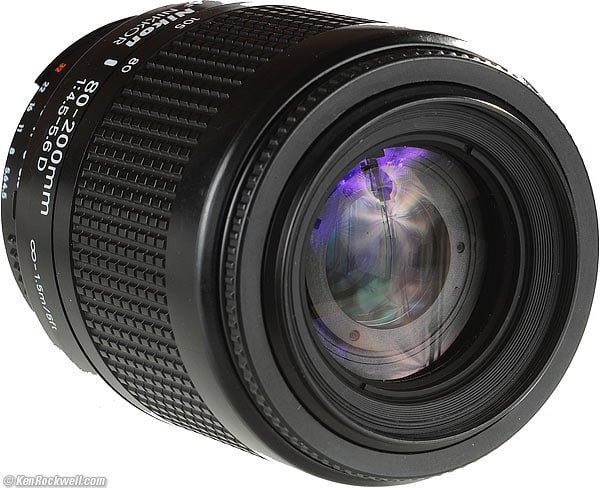
Front, Nikon 80-200mm f/4.5-5.6.
There is no problem with vignetting, even with combinations of thick filters.
The front glass is smaller than the filter ring, and this telephoto lens doesn't see wide angles.
The filter ring rotates with focus but not with zoom.
Lateral Color Fringes back to Performance back to top
There are no lateral color fringes on the D300 or D3, which would correct them if the lens had any.
Macro back to Performance back to top
Roses, 23 November 2014. Nikon D810, 80-200mm at 200mm at f/8 at close-focus distance, 1/250 at ISO 100, Perfectly Clear V2. Camera-original file. Only the rose on the right is partially in focus.
Macro is a generous word for this lens, which only focuses to 5 feet (1.5m).
It doesn't focus very close, but image quality at this distance is excellent, with no color fringes.
The 80-200 4.5-5.6 D AF actually outperforms the expensive manual focus Micro-NIKKOR 200mm f/4 IF AI-s at five feet, since the expensive 200mm Micro ($1,000 back in the 1990s) has obvious lateral color fringes when used on the D3. This plastic lens has no such problem.
Maximum Aperture back to Performance back to top
80mm |
f/4.5 |
105mm |
f/5 |
135mm |
f/5.3 |
200mm |
f/5.6 |
Mechanics back to Performance back to top
Nikon 80-200mm f/4.5-5.6 AF-D. enlarge.
This lens is as dinky as Nikon makes them — so far.
Barrel Exterior
Plastic.
Filter Threads
Plastic.
Focus Ring
Plastic.
Zoom Ring
Solid plastic.
Focus Helicoids
Feel like plastic.
Depth-of-Field Scale
None.
Internals
Look like plastic.
Glass
Glass.
Aperture Ring
Plastic, with painted numbers.
Focus Geartrain
Metal.
Mount
Plastic Mount. enlarge.
Plastic.
Markings
Paint.
Identity Plate
Paint on barrel.
Serial Number
Laser engraved onto bottom rear of aperture ring.
Gasket at mount
No.
Noises When Shaken
Mild dull klunking.
Quality
Made in Japan.
Sharpness back to Performance back to top
Warning 1: Image sharpness depends more on you than your lens.
Warning 2: Lens sharpness doesn't mean much to good photographers.
With those caveats, the 80-200mm f/4.5-5.6 AF is sharp on the D3 and D300.
The only imperfections I see on FX are a softer far left side at 80 and 105mm on my sample. The rest of the frame was sharp and contrasty, even wide open. At the long end it's just little less contrasty wide-open, but not so much that you'd notice it unless you made the same repetitive shots at all apertures as I did and compared them by flipping through images on-screen.
On DX, the corners are the same as the center. It's sharp, but contrast is a little less and there's very light bit of haze wide-open. It's perfect a stop down.
This is why this lens is so impressive, it's just sharp. Other lenses aren't.
Zooming back to Performance back to top
Controls, Nikon 80-200 AF-D. enlarge.
Zooming feels better than many bigger and more expensive lenses. There isn't much to move around when you turn the zoom ring, and the zoom range is very well spread out along the zoom ring.
My beater used sample has a weird hang-up as I try to zoom past 85mm. I have to turn it pretty hard to clear whatever is hanging it up. There is no such hang-up as I zoom back to 80mm. I have no idea what this is; this is what you get buying over eBay.
Here's the kicker: I'm using a lens that most people would have thrown away 10 years ago, and it's the lens which has tested so well above! It's plastic, it's seen a beating, and still churns out great images.
EXIF Encoding Accuracy
EXIF data reads exactly 80, 105, 135 and 200mm when the lens is set there.
Compared top
Samples Intro Specs Performance Compared Recommendations
Mechanically, this is a plastic snapshooter-grade lens with impressively decent optics.
Other Nikkor AF lenses, like the amateur-grade 70-210mm AF lenses, feel much tougher and will take even more of a beating than this lens. The image quality will be about the same.
Nikon's pro f/2.8 zooms will dish out far more of a beating than you're likely to give them, and are two stops faster where you need them. They don't have any less distortion, but could be a tiny bit sharper at f/4-5.6 than this lens.
Nikon's 28-200mm G lens is almost as tiny and has about the same speed, but covers twice the range and focuses over three times as close. It's what I'm more likely to take with me as a goof, but this 80-200mm f/4.5-5.6 lens is sharper wide-open and has less distortion.
None of these lenses compete against each other. They all fill different niches. I don't shoot much tele (I spend most of my creative time at 14mm on FX), so dropping this lens in my pocket could be a possibility if it's all I had. The images are fine, and its small size and weight mean it will be with me on top of the mountain instead of back in the car.
Want to know a secret? The professional 70-200mm f/2.8 VR is designed for news, action and sports. It's not all that sharp in the corners at 200mm, which doesn't bother the pros who use it because it's dangerously sharp in the center 90% of the image where pros put their subjects. If you compare the sharpness of the far corners on FX, this plastic lens is sharper at 200mm!
Recommendations top
Samples Intro Specs Performance Compared Recommendations
The best use of this lens is for saving weight for use with film or FX digital cameras.
Because it has a delicate plastic mount, it feels great mounting and unmounting from a camera, but avoid grabbing your F5 or D3 by this lens. You might break off the mount, and drop your camera while you sit there holding just a lens. Grab any camera by the body, not by this lens.
Deployment
I'd leave either a 52mm Nikon Clear (NC - UV) filter, or a 52mm Hoya Super HMC UV on the lens at all times.
If I was working in nasty, dirty areas, I'd forget a cap, and use an uncoated 52mm Tiffen UV filter instead. Uncoated filters are much easier to clean, but more prone to ghosting.
If you've found all the time, effort and expense I put into researching and sharing all this, this free website's biggest source of support is when you use these links, especially this link directly to them at eBay (see How to Win at eBay), when you get anything, regardless of the country in which you live. Thanks! Ken.
© KenRockwell.com. All rights reserved.
Help me help you top
I support my growing family through this website, as crazy as it might seem.
The biggest help is when you use any of these links to approved sources when you get anything, regardless of the country in which you live. It costs you nothing, and is this site's, and thus my family's, biggest source of support. These places have the best prices and service, which is why I've used them since before this website existed. I recommend them all personally.
If you find this page as helpful as a book you might have had to buy or a workshop you may have had to take, feel free to help me continue helping everyone.
If you've gotten your gear through one of my links or helped otherwise, you're family. It's great people like you who allow me to keep adding to this site full-time. Thanks!
If you haven't helped yet, please do, and consider helping me with a gift of $5.00.
As this page is copyrighted and formally registered, it is unlawful to make copies, especially in the form of printouts for personal use. If you wish to make a printout for personal use, you are granted one-time permission only if you PayPal me $5.00 per printout or part thereof. Thank you!
Thanks for reading!
Mr. & Mrs. Ken Rockwell, Ryan and Katie.
Home Donate New Search Gallery Reviews How-To Books Links Workshops About Contact

